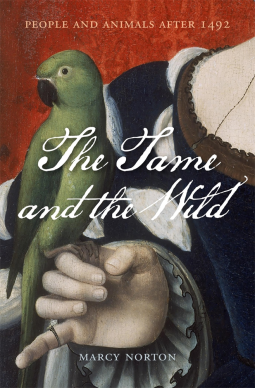
The Tame and the Wild
People and Animals after 1492
by Marcy Norton
This title was previously available on NetGalley and is now archived.
Send NetGalley books directly to your Kindle or Kindle app
1
To read on a Kindle or Kindle app, please add kindle@netgalley.com as an approved email address to receive files in your Amazon account. Click here for step-by-step instructions.
2
Also find your Kindle email address within your Amazon account, and enter it here.
Pub Date Jan 09 2024 | Archive Date Jan 09 2024
Talking about this book? Use #TheTameandtheWild #NetGalley. More hashtag tips!
Description
A dramatic new interpretation of the encounter between Europe and the Americas that reveals the crucial role of animals in the shaping of the modern world.
When the men and women of the island of Guanahani first made contact with Christopher Columbus and his crew on October 12, 1492, the cultural differences between the two groups were vaster than the oceans that had separated them. There is perhaps no better demonstration than the divide in their respective ways of relating to animals. In The Tame and the Wild, Marcy Norton tells a new history of the colonization of the Americas, one that places wildlife and livestock at the center of the story. She reveals that the encounters between European and Native American beliefs about animal life transformed societies on both sides of the Atlantic.
Europeans’ strategies and motives for conquest were inseparable from the horses that carried them in military campaigns and the dogs they deployed to terrorize Native peoples. Even more crucial were the sheep, cattle, pigs, and chickens whose flesh became food and whose skins became valuable commodities. Yet as central as the domestication of animals was to European plans in the Americas, Native peoples’ own practices around animals proved just as crucial in shaping the world after 1492. Cultures throughout the Caribbean, Amazonia, and Mexico were deeply invested in familiarization: the practice of capturing wild animals—not only parrots and monkeys but even tapir, deer, and manatee—and turning some of them into “companion species.” These taming practices not only influenced the way Indigenous people responded to human and nonhuman intruders but also transformed European culture itself, paving the way for both zoological science and the modern pet.
Marcy Norton is Associate Professor of History at the University of Pennsylvania and the author of the award-winning Sacred Gifts, Profane Pleasures: A History of Tobacco and Chocolate in the Atlantic World. Her research has been supported by fellowships from the Guggenheim Foundation, the Library of Congress, and the Huntington Library.
Advance Praise
“The Tame and the Wild reads like a revelation. Norton’s groundbreaking work compellingly shows how the history of nonhuman animals in the Atlantic world, and their transformation from beings to things, is intrinsically entangled with the history of the early-modern European extractivist and genocidal colonial project in the Americas. At the same time, it luminously recovers and foregrounds early-modern American Indigenous ways of being in the world and knowing it that emphasize the shared nature of human and nonhuman flesh and subjectivity. Her book shows us new ways for writing both our histories and those of our ‘fellow creatures.’”—Pablo F. Gómez, author of The Experiential Caribbean: Creating Knowledge and Healing in the Early Modern Atlantic
“Marcy Norton offers an erudite and innovative perspective on the relationships between humankind and animals in the context of the European colonization of Mexico and South America. By analyzing the history of the clash between Indigenous and Western conceptions of hunting, domestication, and coexistence with pets, this book reveals the origins of consumption practices and objectification of the animal world, as well as the struggles to recognize animal rights.”—Guilhem Olivier, National Autonomous University of Mexico
“Norton revolutionizes our understanding of the world after 1492. Until now theories of ecological imperialism have conceived of animals a lot like diseases: as biological forces undermining colonized societies. She refutes that determinist story by showing animals as subjects in relationships—sometimes tender, sometimes violent, sometimes extractivist—with Indigenous people and Europeans in the Americas. The Tame and The Wild puts animals and human relationships at the center of the history of contact.”—Nancy J. Jacobs, author of Birders of Africa
Available Editions
| EDITION | Hardcover |
| ISBN | 9780674737525 |
| PRICE | $37.95 (USD) |
| PAGES | 448 |



